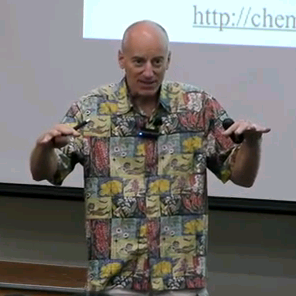UCI Chem 131C Thermodynamics and Chemical Dynamics (Spring 2012)
Lec 25. Thermodynamics and Chemical Dynamics -- Enzymes Pt. II --
View the complete course: ../courses/chem_131c_thermodynamics_and_chemical_dynamics.html
Instructor: Reginald Penner, Ph.D.
License: Creative Commons BY-NC-SA
Terms of Use: ../info.
More courses at http://ocw.uci.edu
Description: In Chemistry 131C, students will study how to calculate macroscopic chemical properties of systems. This course will build on the microscopic understanding (Chemical Physics) to reinforce and expand your understanding of the basic thermo-chemistry concepts from General Chemistry (Physical Chemistry.) We then go on to study how chemical reaction rates are measured and calculated from molecular properties. Topics covered include: Energy, entropy, and the thermodynamic potentials; Chemical equilibrium; and Chemical kinetics. This video is part of a 27-lecture undergraduate-level course titled "Thermodynamics and Chemical Dynamics" taught at UC Irvine by Professor Reginald M. Penner.
Thermodynamics and Chemical Dynamics (Chem 131C) is part of OpenChem: ../openchem/
Recorded on June 4, 2012.
Index of Topics:
00:06 - Enzymes (Second & Final Attempt)
00:45 - Announcements
02:42 - Chem 1 Students...
04:47 - Today: Enzyme Kinetics, Enzyme Inhibition
5:00 - How Enzymes Catalyze Reactions
07:27 - Equations Specific to Enzyme Catalysis, Rate of Reaction
12:36 - The Michaelis-Menten Equation
13:04 - Simplifying the Rate of Reaction
15:20 - Making the Michaelis-Menten Equation Useful
15:46 - What's Happening if K2 is big?
16:56 - If K2 is Big, if [S] is Big
17:56 - And if [S] is Big, Then...
19:49 - IF [S] is Small
20:27 - Plot of Reaction Rate vs. Concentration of S
23:57 - K2=Kcat=Turnover Number
24:30 - Ratio Between V and Vmax
25:34 - Basis for the Lineweaver-Burk Plot
27:15 - The Lineweaver-Burk Plot
28:30 - Problem From Last Year's Final Exam
31:28 - What Could Possibly Happen to Mess This Up?
32:56 - Classifying Inhibitors Based Upon Their Effect on the Lineweaver-Burk Plot
34:46 - Three Flavors of Enzyme Inhibition: Competitive Inhibition
35:10 - Out Competing a Competitive Inhibitor: Plot
37:10 - What Influence Does Vmax Have on the Lineweaver-Burk Plot?
37:57 - Noncompetitive Inhibition
39:28 - Uncompetitive Inhibition
40:26 - Derive the Math For the Plots
43:13 - No Inhibitor/Inhibitor Equations
44:07 - Table of Inhibition
45:18 - The Classical Case of Competitive Inhibition: Malonate and SD
46:09 - Succinate
46:15 - Fumarate
46:36 - Competitive Inhibitors Generally Resemble the Substrate of the Protein to which They Bind
Required attribution: Penner, Reginald Thermodynamics and Chemical Dynamics 131C (UCI OpenCourseWare: University of California, Irvine), ../courses/chem_131c_thermodynamics_and_chemical_dynamics.html. [Access date]. License: Creative Commons Attribution-ShareAlike 3.0 United States License.


